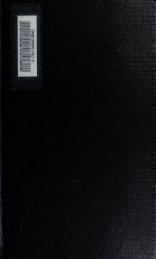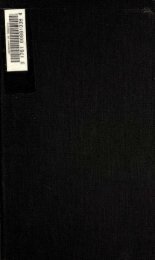Texts from the Buddhist canon : commonly known as Dhammapada
Texts from the Buddhist canon : commonly known as Dhammapada
Texts from the Buddhist canon : commonly known as Dhammapada
Create successful ePaper yourself
Turn your PDF publications into a flip-book with our unique Google optimized e-Paper software.
INTRODUCTION. 9<br />
impetus given to <strong>Buddhist</strong> research at <strong>the</strong> time alluded<br />
to, <strong>the</strong>re can be no difficulty in accepting this position.<br />
The writings of AsaSgha, V<strong>as</strong>ubandhu, Mg§,rjuua, V<strong>as</strong>u-<br />
mitra, and o<strong>the</strong>rs who lived during <strong>the</strong> first century B.C.,<br />
are accepted in <strong>the</strong> Nor<strong>the</strong>rn School of Buddhism <strong>as</strong><br />
authoritative. They have just that weight and character<br />
which works written by those called "Fa<strong>the</strong>rs of <strong>the</strong><br />
Christian Church " have in Christendom. In <strong>the</strong> Chinese<br />
Tripitaka <strong>the</strong>re is no effort to conceal <strong>the</strong> human composi-<br />
tion of <strong>the</strong>se books. On <strong>the</strong> title page of every Sh<strong>as</strong>ter<br />
<strong>the</strong> author's name is given—<strong>the</strong>y are called "Sutr<strong>as</strong>" or<br />
" Sh<strong>as</strong>ters "—but yet with <strong>the</strong> plain intimation that <strong>the</strong>y<br />
were drawn up by men who lived long after <strong>the</strong> age of<br />
what we should -call " inspiration." If, <strong>the</strong>n, <strong>the</strong>se ' o<strong>the</strong>r<br />
writers are regarded with reverence, equally so we may<br />
<strong>as</strong>sume w<strong>as</strong> <strong>the</strong> author of <strong>the</strong> present work. In any c<strong>as</strong>e<br />
it is of importance that we have here provided for us a<br />
definite <strong>as</strong>sertion <strong>as</strong> to <strong>Dhammapada</strong>, with respect to its<br />
date and author—about which <strong>the</strong> Sou<strong>the</strong>rn Eecords, beyond<br />
<strong>the</strong> general <strong>as</strong>signation of this work to a portion of<br />
<strong>the</strong> <strong>canon</strong>, affirm nothiag.<br />
It now remains to consider what reliance may be<br />
placed generally on <strong>the</strong>se Chinese versions of <strong>the</strong> Sacred<br />
Books of thf <strong>Buddhist</strong>s. At <strong>the</strong> very outset of this con-<br />
sideration we observe that <strong>the</strong>y were made, if not by, yet<br />
under <strong>the</strong> immediate direction of, Indian priests. It would<br />
be <strong>as</strong> incorrect to refer <strong>the</strong> originals of <strong>the</strong> Christian<br />
Scriptures now used in China to native writers, <strong>as</strong><br />
to make <strong>the</strong> <strong>Buddhist</strong> books found <strong>the</strong>re a part of <strong>the</strong><br />
native literature. Buddhism w<strong>as</strong> brought to Chtaa by<br />
missionaries <strong>from</strong> India, and <strong>the</strong> books forming <strong>the</strong> <strong>canon</strong><br />
(except where expressly named <strong>as</strong> Chinese) are transla-<br />
tions made by those men <strong>from</strong> some Indian vernacular.<br />
This leads to ano<strong>the</strong>r remark in correction of an oft-repeated<br />
<strong>as</strong>sertion that Chinese <strong>Buddhist</strong> books are aU<br />
translations of Sanscrit works found in Mpal. It is so<br />
plain to any one conversant with <strong>the</strong> subject that such is<br />
'





